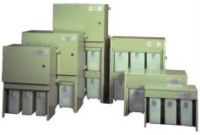RED
 Electrolytic starters for low and medium power cage synchronous motors
Electrolytic starters for low and medium power cage synchronous motors
RED statormatic electrolytic starters for cage motors offer an unrivalled starting capability up to 750 kW.
- Reliable: no moving parts, no current peak during starting process
- Economical: reduced maintenance
- Customizable to specific motor requirements



